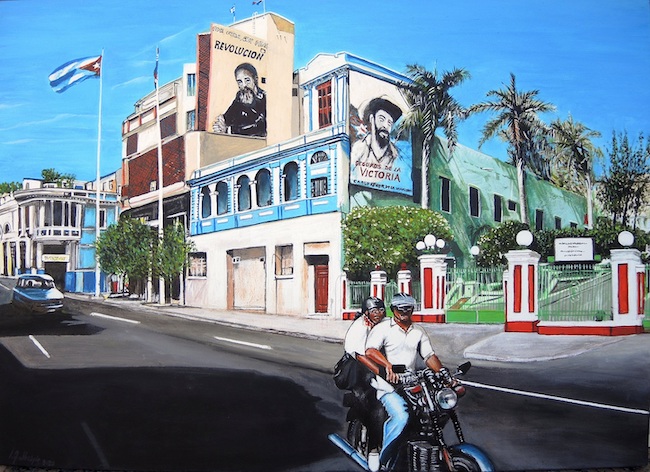L’indole dell’esplorazione, quel tendere verso la scoperta e la conoscenza di tutto ciò che è distante dalla cultura di origine, appartiene da sempre agli artisti di ogni epoca, alcune volte manifestata come ispirazione delle proprie opere, altre invece trasformata in vera e propria narrazione di quei mondi da cui l’esecutore della tela si era lasciato ammaliare. L’artista di cui sto per parlarvi oggi descrive tutto ciò da cui il suo sguardo è stato colpito nel momento in cui quei luoghi diversi erano parte della sua realtà.
Nel corso della storia dell’arte moderna, in particolare quella iniziata negli ultimi anni dell’Ottocento e proseguita poi per tutta la prima metà del Novecento, si delineò tra gli ambienti culturali europei un forte interesse per tutte le culture esotiche appartenenti alle colonie delle nazioni principali conquistate durante il periodo di esplorazione e di colonizzazione mosso per ampliare il proprio predominio nel mondo. L’Oriente, l’Africa, l’Oceania, con i loro usi e costumi primitivi e lontani da quelli della civiltà del vecchio continente, suscitarono la curiosità degli studiosi, dei medici e degli antropologi, ma anche degli artisti che in quella diversità trovarono una nuova fonte di ispirazione e di studio facilitati dall’impulso al viaggio e agli spostamenti che contraddistinsero quell’epoca di scoperte. Il Primitivismo fu alla base non solo del Cubismo di Picasso che attinse alle maschere africane per elaborare i suoi volti distorti e multifocali, bensì anche della ricerca scultorea di Amedeo Modigliani, per il breve tempo durante il quale riuscì a lavorare la materia prima della scoperta della sua malattia respiratoria che gli impedì di continuare a scolpire, e anche della maggior parte della produzione artistica di Paul Gauguin che raccontò la bellezza incontaminata e semplice degli scorci di Tahiti e la spontaneità e naturalezza nell’approccio alla sessualità delle sue donne, tanto quanto la malìa che quel mondo esercitò su di lui al punto di volervi restare. Ma anche altri espressionisti come il francese André Derain, il tedesco Ernst Ludwig Kirchner e il danese Emil Nolde non sfuggirono al fascino dell’esplorazione del mistero di quei mondi sconosciuti, selvaggi eppure pieni di spunti di riflessione sia dal punto di vista culturale ma anche da quello morale, scientifico, formativo e di apertura verso il diverso. Nell’epoca contemporanea i viaggi sono stati notevolmente facilitati fino al punto di entrare a far parte del quotidiano professionale e di svago della maggior parte delle persone, eppure quell’attrazione verso la conoscenza e la scoperta di paesi lontani dalla propria cultura permane e si alimenta nel processo di crescita dell’individuo; va da sé che anche l’arte non smetta di narrare e interpretare luoghi e paesaggi in cui tutto, a partire dagli scorci e dalle vedute per finire allo stile di vita, è differente dal mondo in cui si è abituati a vivere. Luciano Fabbrizio, artista frosinate con una grande inclinazione verso la conoscenza e l’approccio con modi di vivere e di intendere la quotidianità differenti dal proprio, sceglie di raccontare attraverso uno stile figurativo di matrice Realista i luoghi e gli scorci da cui è rimasto affascinato durante i suoi viaggi, coglie i frammenti di routine distratta di cui chi ne è protagonista ignora la fascinazione che possono esercitare su un osservatore esterno.
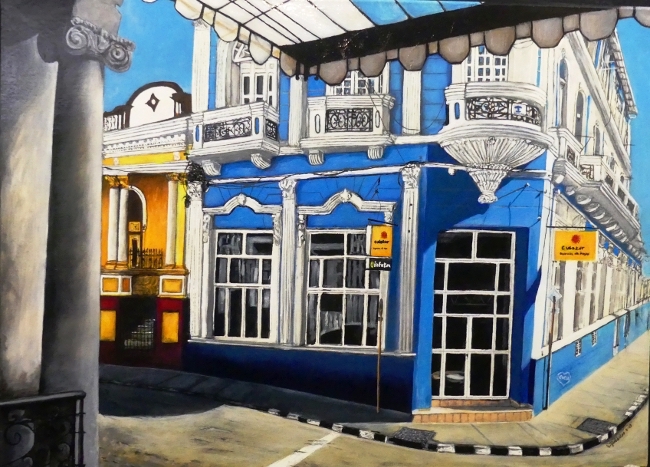
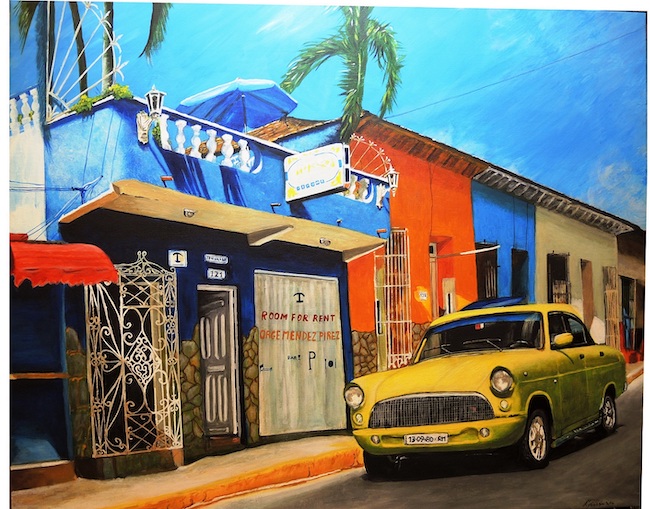
La straordinarietà dunque emerge dall’ordinario, o per meglio dire in virtù di esso, grazie al filtro emozionale dell’artista, quel saper interpretare da una prospettiva inedita tutto ciò che diversamente si nasconderebbe dentro le pieghe del vivere comune, della ripetitività dell’esistenza; la capacità narrativa di Fabbrizio consiste esattamente in quel trasmettere l’emozione che egli stesso ha percepito nel momento in cui la sua natura curiosa ha scoperto i luoghi che poi ha sentito la necessità di raffigurare, per far conoscere all’osservatore il suo punto di vista sul viaggio che è visita rispettosa e silenziosa della realtà esistente, e per ripercorrere le sensazioni vissute, le memorie di quei momenti indimenticabili in cui ciò che ha visto ha segnato la sua indole di scopritore di bellezza.
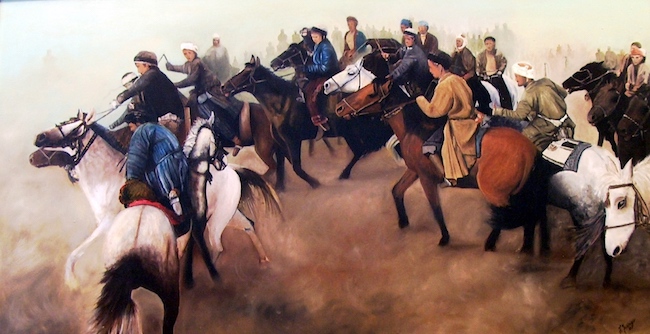
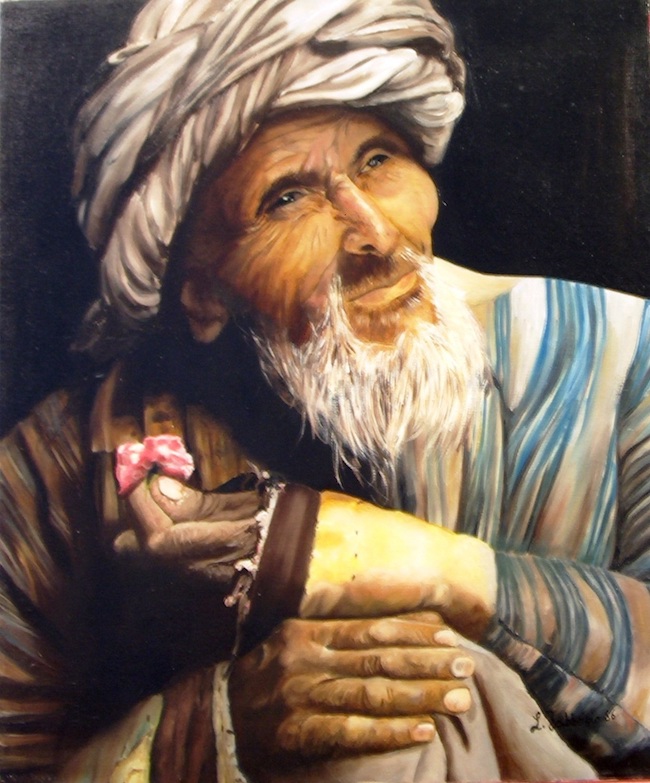
Le tele dedicate all’Afghanistan, Afghano con la rosa e Cavalieri afghani, mostrano il suo tratto realista che gli permette non solo di descrivere dettagliatamente l’espressione intensa e al tempo stessa serena dell’uomo protagonista della prima opera, ma anche l’atmosfera morbida e poetica di cui lo circonda, come se lo sguardo stesso dell’artista si fosse rispettosamente ammorbidito davanti all’evidente saggezza senile che accomuna gli avi di ogni parte del mondo. Ma la fascinazione maggiore Luciano Fabbrizio la subisce visitando Cuba, un’isola incantata fatta di musica e colori vivaci, tanto quanto lo è la sua popolazione, che non può fare a meno di conquistare completamente l’artista. È proprio l’ambiente a cogliere il suo sguardo, quella poliedricità cromatica che contraddistingue gli edifici e che sembra mettere in risalto la polverosità delle strade, spesso immortalate nella loro tranquillità, nei momenti in cui il traffico si addormenta e la bellezza inconsapevole di quel mondo tropicale fuoriesce e travolge la vista.
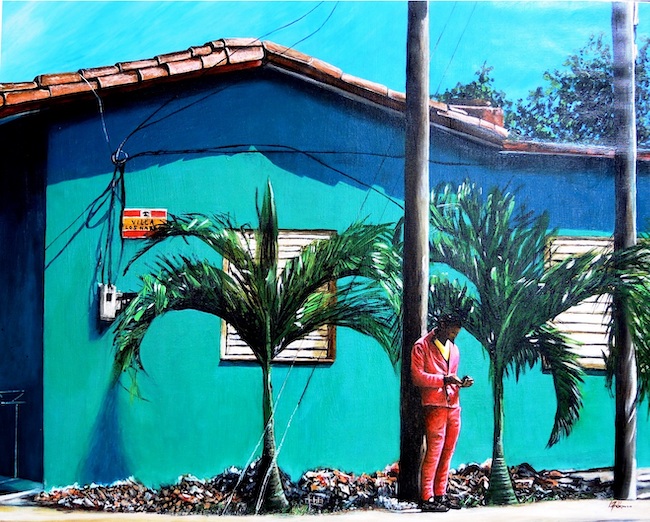
Nella tela L’Attesa Fabbrizio racconta il ritmo di vita lento e rilassato che contraddistingue il popolo cubano, quell’essere nel momento presente senza lasciarsi prendere dalla frenesia e dal dover correre verso le cose da fare, dagli impegni a cui attendere, che appartengono invece al mondo occidentale; i colori sono intensi, pieni di luce come lo è tutta l’isola e l’artista ne ripropone scorci e ne mette in risalto dettagli nascosti, quegli angoli lontani dai percorsi turistici che rivelano la vera essenza del luogo.
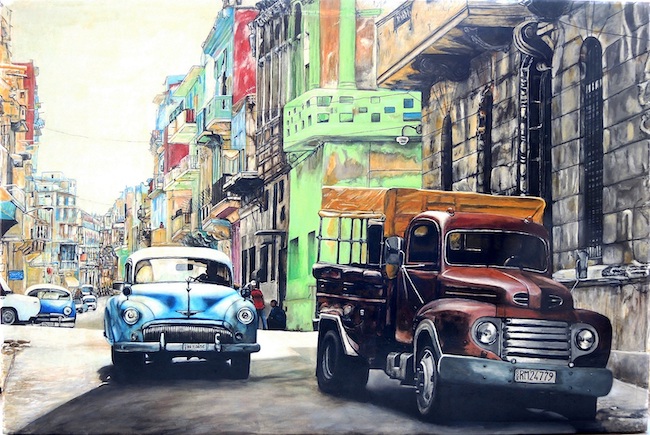
In I love Cuba invece sottolinea la vitalità della capitale, L’Avana, in cui il tempo sembra essersi fermato in quegli anni Cinquanta in cui le auto avevano un aspetto completamente differente rispetto a quelle moderne a cui il resto del mondo è abituato, evidenziandone l’aspetto folcloristico e fortemente distintivo che si lega alla vita del luogo; in questo caso Luciano Fabbrizio si pone in posizione di ascolto verso il traffico cittadino, quel rumoreggiare di strada che caratterizza la cultura isolana, quell’essere presenti per vivere in pieno ciascun frangente, cogliere ogni attimo che l’esistenza regala con il sorriso sulle labbra e la pazienza di chi non ha fretta, di chi non si preoccupa se deve fermarsi a far ripartire il motore dell’auto, troppo antica per essere efficiente. All’aspetto rilassato e quasi decadente della capitale l’artista contrappone invece la cura coloniale che caratterizza Santiago, una città in cui le tradizioni e le origini africane del popolo cubano sono conservate in maniera più incisiva pur avendo un approccio quasi europeo alla vita, più ordinato, più dedito al lavoro e alla cura del meraviglioso luogo in cui i suoi cittadini vivono, molto più che gli habaneros orientati invece al divertimento e alla spensieratezza.
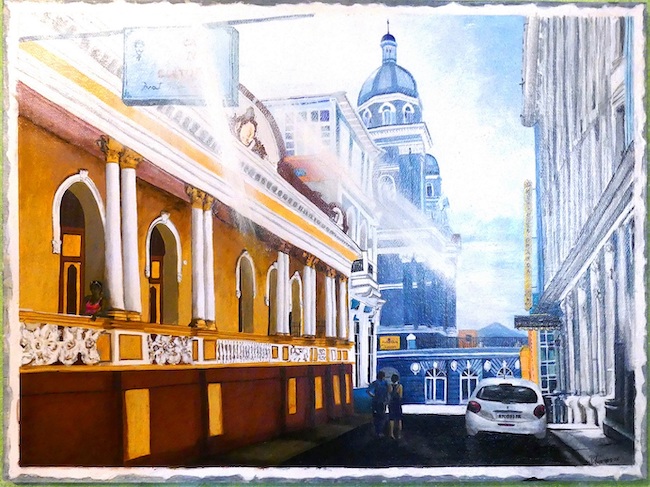
Il tocco realista di Luciano Fabbrizio scopre, come sotto una luce teatrale, le meraviglie della città, trasformando il suo sguardo in obiettivo fotografico per non trascurare nulla, per non dimenticare quei particolari osservati e ammirati durante un viaggio indimenticabile; il lavoro Casa de la cultura di Santiago immortala uno degli edifici simbolo dell’antica capitale, che presenta tutte le caratteristiche tipiche dell’isola, a partire dai colori degli edifici intensi e vivaci per finire alle persone che si intrattengono a chiacchierare in strada e che sono attori secondari, comprimari, rispetto al meraviglioso scenario naturale e architettonico dell’isola di Cuba. Artista da sempre, Luciano Fabbrizio ha effettuato un percorso che lo ha condotto a sperimentare diversi stili artistici, mostrando un eclettismo stilistico che lo induce a continuare a mettersi in discussione e misurarsi con nuove sfide; fa parte dell’Associazione dei Cento Pittori di via Margutta, con cui espone e collabora in maniera continuativa dal 1999.
LUCIANO FABBRIZIO-CONTATTI
Email: astrattolucio@yahoo.it
Sito web: www.lucianofabbrizio.com
Facebook: https://www.facebook.com/profile.php?id=1365784790
The fascinated gaze towards distant countries in Luciano Fabbrizio’s Realism
The nature of exploration, that tendency towards the discovery and knowledge of all that is distant from the culture of origin, has always belonged to artists of every age, sometimes manifested as the inspiration for their artworks, other times transformed into a true narration of those worlds by which the artist of the canvas had allowed himself to be captivated. The artist I am going to tell you about today describes everything that caught his eye when those different places were part of his reality.
Throughout the history of modern art, particularly that which began in the last years of the nineteenth century and continued throughout the first half of the twentieth century, was emerging in European cultural circles a strong interest in all the exotic cultures belonging to the colonies of the main nations conquered during the period of exploration and colonisation aimed at extending their dominance in the world. The Orient, Africa and Oceania, with their primitive customs and habits, far from those of the civilisation of the old continent, aroused the curiosity of scholars, doctors and anthropologists, but also of artists who found in this diversity a new source of inspiration and study, facilitated by the impulse to travel and movement that characterised that era of discovery. Primitivism was the basis not only of Picasso’s Cubism, which drew on African masks to elaborate his distorted and multifocal faces, but also of Amedeo Modigliani’s sculptural research, for the short time he was able to work with the material before the discovery of his respiratory disease which prevented him from continuing to sculpt, as well as most of Paul Gauguin’s artistic production, which recounted the uncontaminated aand simple beauty of Tahitian views and the spontaneity and naturalness of the approach to sexuality of its women, as well as the malice that this world exerted on him to the point of wanting to remain there. But other Expressionists such as the Frenchman André Derain, the German Ernst Ludwig Kirchner and the Danish Emil Nolde did not escape the fascination of exploring the mystery of those unknown worlds, wild and yet full of food for thought from a cultural point of view, but also from a moral, scientific, educational and open-minded point of view.
In modern times, travel has been greatly facilitated to the point where it has become part of most people’s daily work and leisure activities, yet that attraction towards the knowledge and discovery of countries far from one’s own culture persists and is nourished in the individual’s growth process. It goes without saying that art, too, never ceases to narrate and interpret places and landscapes where everything, from the views and vistas to the lifestyle, is different from the world in which one is used to living. Luciano Fabbrizio, an artist from Frosinone with a great inclination towards knowledge and approach to ways of living and understanding everyday life different from his own, chooses to tell through a figurative style of Realist matrix the places and views he has been fascinated by during his travels, capturing the fragments of distracted routine of which those who are the protagonists ignore the fascination they can exert on an external observer. The extraordinary therefore emerges from the ordinary, or rather by virtue of it, thanks to the artist’s emotional filter, his ability to interpret from a new perspective all that which would otherwise be hidden within the folds of ordinary life, of the repetitiveness of existence; Fabbrizio’s narrative capacity consists precisely in transmitting the emotions that he himself has perceived at the moment when his curious nature discovered the places that he then felt the need to depict, in order to let the observer know his point of view on the journey, which is a respectful and silent visit to existing reality, and to retrace the sensations experienced, the memories of those unforgettable moments in which what he has seen has marked his nature of discoverer of beauty. The canvases dedicated to Afghanistan, Afghan with a Rose and Afghan Knights, show his realistic stroke that allows him not only to describe in detail the intense and at the same time serene expression of the man protagonist of the first painting, but also the soft and poetic atmosphere that surrounds him, as if the artist’s own gaze had respectfully softened in front of the evident senile wisdom that is common to ancestors from all over the world.
But the greatest fascination for Luciano Fabbrizio came when he visited Cuba, an enchanted island made up of music and bright colours, as much as its population, which cannot help but completely captivate the artist. It is the environment that catches his eye, that chromatic versatility that distinguishes the buildings and seems to highlight the dustiness of the streets, often immortalised in their tranquillity, in the moments when the traffic falls asleep and the unconscious beauty of that tropical world emerges and overwhelms the view. In the canvas L’Attesa (Waiting) Fabbrizio recounts the slow and relaxed pace of life that distinguishes the Cuban people, that being in the present moment without being caught up in the frenzy and the need to hurry towards things to do, commitments to attend to, which instead belong to the western world; the colours are intense, full of light, as the whole island is, and the artist presents glimpses and highlights hidden details, those corners far from the tourist routes that reveal the true essence of the place. In I love Cuba, on the other hand, he emphasises the vitality of the capital, Havana, where time seems to have stood still in those 1950s when cars had a completely different appearance to the modern ones the rest of the world is used to, highlighting the folkloric and highly distinctive aspect that is linked to the life of the place; in this case, Luciano Fabbrizio listens to the city traffic, to the street noise that characterises the island’s culture, to being present in order to live each moment to the full, to seize every moment that existence offers with a smile on his lips and the patience of someone who is not in a hurry, who does not worry if he has to stop and restart his car engine, which is too old to be efficient. The artist contrasts the relaxed and almost decadent aspect of the capital with the colonial care that characterises Santiago, a city in which the traditions and African origins of the Cuban people are preserved in a more incisive manner, even though it has an almost European approach to life, more orderly, more dedicated to work and to looking after the wonderful place in which its citizens live, much more than the habaneros, who are instead oriented towards fun and carefree living.
Luciano Fabbrizio’s realistic touch discovers, as if under a theatrical light, the wonders of the city, transforming his gaze into a photographic lens so as not to overlook anything, not to forget those details observed and admired during an unforgettable journey; The work Casa de la cultura de Santiago (House of culture in Santiago) immortalises one of the symbolic buildings of the ancient capital, which has all the typical characteristics of the island, starting with the intense and lively colours of the buildings and ending with the people chatting in the street, who are secondary actors, comprimarios, compared to the marvellous natural and architectural scenery of the island of Cuba. Luciano Fabbrizio has always been an artist, and his journey has led him to experiment with different artistic styles, showing a stylistic eclecticism that prompts him to continue to question and measure himself with new challenges; he is part of the Associazione dei Cento Pittori di via Margutta, with which he has been exhibiting and collaborating continuously since 1999.
LUCIANO FABBRIZIO-CONTACTS
Email: astrattolucio@yahoo.it
Website: www.lucianofabbrizio.com
Facebook: https://www.facebook.com/profile.php?id=1365784790


